Leadership, Management and Operations: Tesco Case Study
VerifiedAdded on 2020/06/06
|10
|2401
|459
Report
AI Summary
This report provides a comprehensive analysis of leadership and management, exploring the roles and characteristics of leaders and managers within an organizational context. It delves into the practical application of these roles, examining how leaders motivate workers, set visions, and provide direction, while managers focus on planning, organizing, directing, staffing, leading, and controlling. The report then examines various leadership theories, including the Great Man theory, trait theory, behavioral theory, contingency theory, situational leadership, and systems theory, with a particular emphasis on the applicability of the contingency style to modern business environments, using Tesco as a case study. Finally, the report concludes by highlighting the importance of operational management and the impact of both internal and external factors on a business environment. The provided references support the research and analysis, offering additional insights into the subject matter.
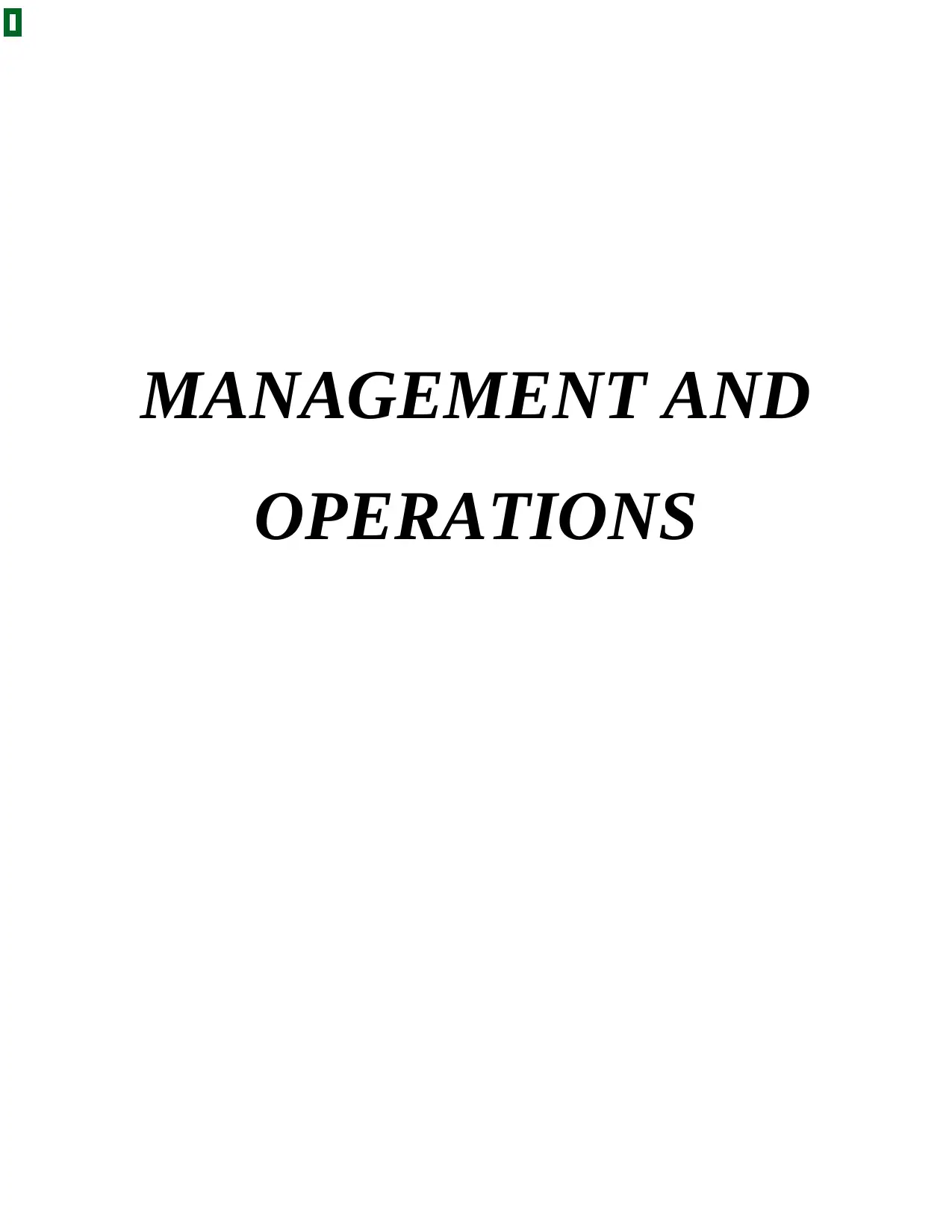
MANAGEMENT AND
OPERATIONS
OPERATIONS
Paraphrase This Document
Need a fresh take? Get an instant paraphrase of this document with our AI Paraphraser
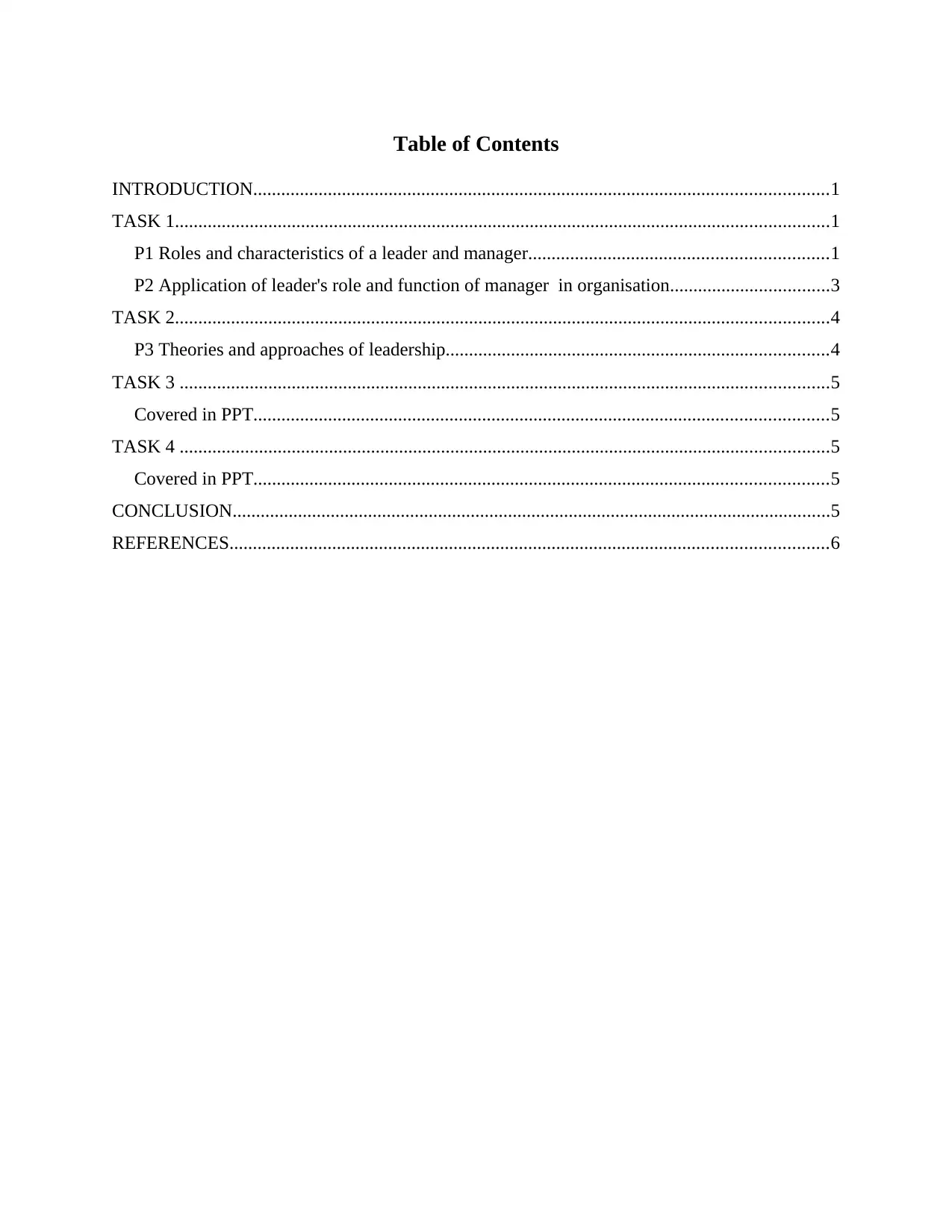
Table of Contents
INTRODUCTION...........................................................................................................................1
TASK 1............................................................................................................................................1
P1 Roles and characteristics of a leader and manager................................................................1
P2 Application of leader's role and function of manager in organisation..................................3
TASK 2............................................................................................................................................4
P3 Theories and approaches of leadership..................................................................................4
TASK 3 ...........................................................................................................................................5
Covered in PPT...........................................................................................................................5
TASK 4 ...........................................................................................................................................5
Covered in PPT...........................................................................................................................5
CONCLUSION................................................................................................................................5
REFERENCES................................................................................................................................6
INTRODUCTION...........................................................................................................................1
TASK 1............................................................................................................................................1
P1 Roles and characteristics of a leader and manager................................................................1
P2 Application of leader's role and function of manager in organisation..................................3
TASK 2............................................................................................................................................4
P3 Theories and approaches of leadership..................................................................................4
TASK 3 ...........................................................................................................................................5
Covered in PPT...........................................................................................................................5
TASK 4 ...........................................................................................................................................5
Covered in PPT...........................................................................................................................5
CONCLUSION................................................................................................................................5
REFERENCES................................................................................................................................6
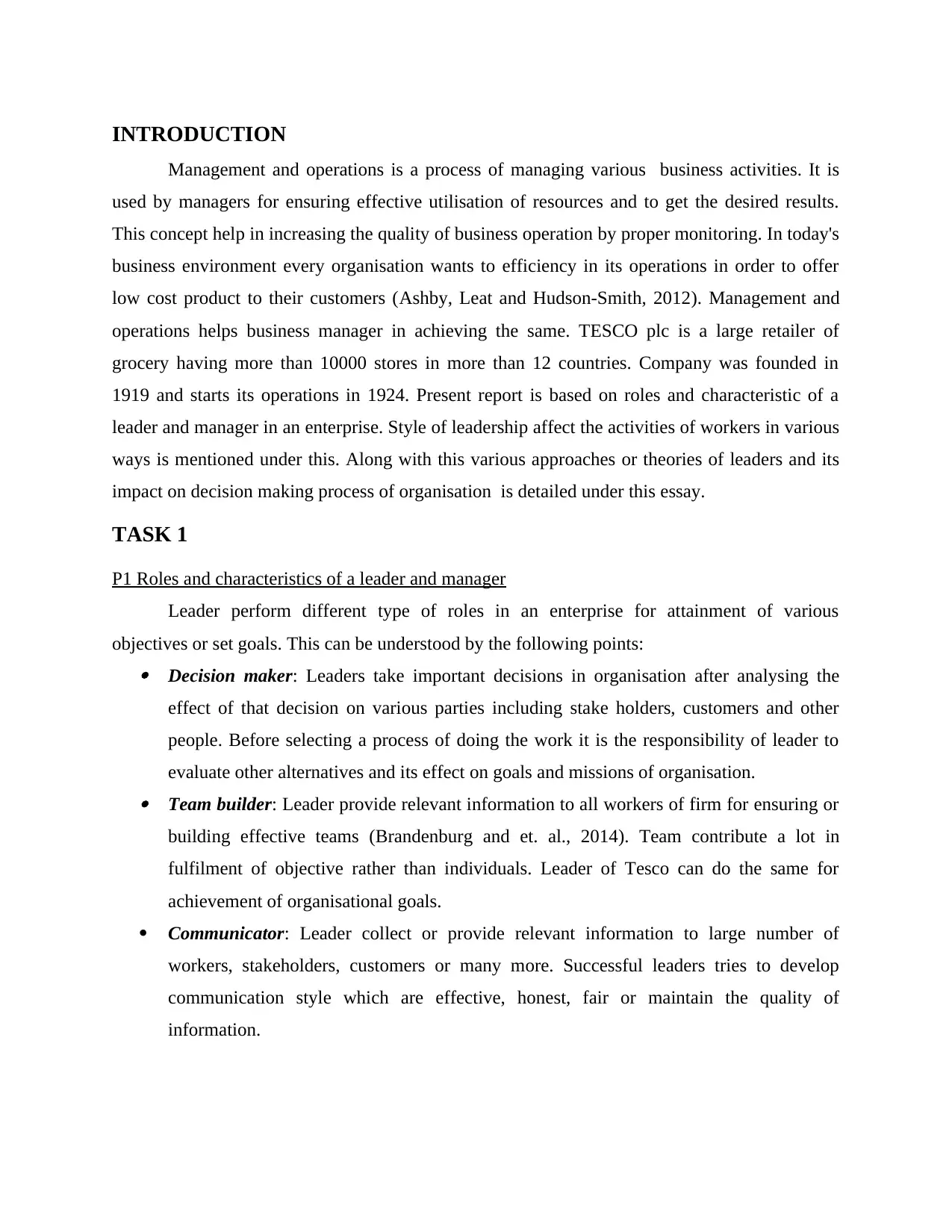
INTRODUCTION
Management and operations is a process of managing various business activities. It is
used by managers for ensuring effective utilisation of resources and to get the desired results.
This concept help in increasing the quality of business operation by proper monitoring. In today's
business environment every organisation wants to efficiency in its operations in order to offer
low cost product to their customers (Ashby, Leat and Hudson-Smith, 2012). Management and
operations helps business manager in achieving the same. TESCO plc is a large retailer of
grocery having more than 10000 stores in more than 12 countries. Company was founded in
1919 and starts its operations in 1924. Present report is based on roles and characteristic of a
leader and manager in an enterprise. Style of leadership affect the activities of workers in various
ways is mentioned under this. Along with this various approaches or theories of leaders and its
impact on decision making process of organisation is detailed under this essay.
TASK 1
P1 Roles and characteristics of a leader and manager
Leader perform different type of roles in an enterprise for attainment of various
objectives or set goals. This can be understood by the following points: Decision maker: Leaders take important decisions in organisation after analysing the
effect of that decision on various parties including stake holders, customers and other
people. Before selecting a process of doing the work it is the responsibility of leader to
evaluate other alternatives and its effect on goals and missions of organisation. Team builder: Leader provide relevant information to all workers of firm for ensuring or
building effective teams (Brandenburg and et. al., 2014). Team contribute a lot in
fulfilment of objective rather than individuals. Leader of Tesco can do the same for
achievement of organisational goals.
Communicator: Leader collect or provide relevant information to large number of
workers, stakeholders, customers or many more. Successful leaders tries to develop
communication style which are effective, honest, fair or maintain the quality of
information.
Management and operations is a process of managing various business activities. It is
used by managers for ensuring effective utilisation of resources and to get the desired results.
This concept help in increasing the quality of business operation by proper monitoring. In today's
business environment every organisation wants to efficiency in its operations in order to offer
low cost product to their customers (Ashby, Leat and Hudson-Smith, 2012). Management and
operations helps business manager in achieving the same. TESCO plc is a large retailer of
grocery having more than 10000 stores in more than 12 countries. Company was founded in
1919 and starts its operations in 1924. Present report is based on roles and characteristic of a
leader and manager in an enterprise. Style of leadership affect the activities of workers in various
ways is mentioned under this. Along with this various approaches or theories of leaders and its
impact on decision making process of organisation is detailed under this essay.
TASK 1
P1 Roles and characteristics of a leader and manager
Leader perform different type of roles in an enterprise for attainment of various
objectives or set goals. This can be understood by the following points: Decision maker: Leaders take important decisions in organisation after analysing the
effect of that decision on various parties including stake holders, customers and other
people. Before selecting a process of doing the work it is the responsibility of leader to
evaluate other alternatives and its effect on goals and missions of organisation. Team builder: Leader provide relevant information to all workers of firm for ensuring or
building effective teams (Brandenburg and et. al., 2014). Team contribute a lot in
fulfilment of objective rather than individuals. Leader of Tesco can do the same for
achievement of organisational goals.
Communicator: Leader collect or provide relevant information to large number of
workers, stakeholders, customers or many more. Successful leaders tries to develop
communication style which are effective, honest, fair or maintain the quality of
information.
⊘ This is a preview!⊘
Do you want full access?
Subscribe today to unlock all pages.

Trusted by 1+ million students worldwide
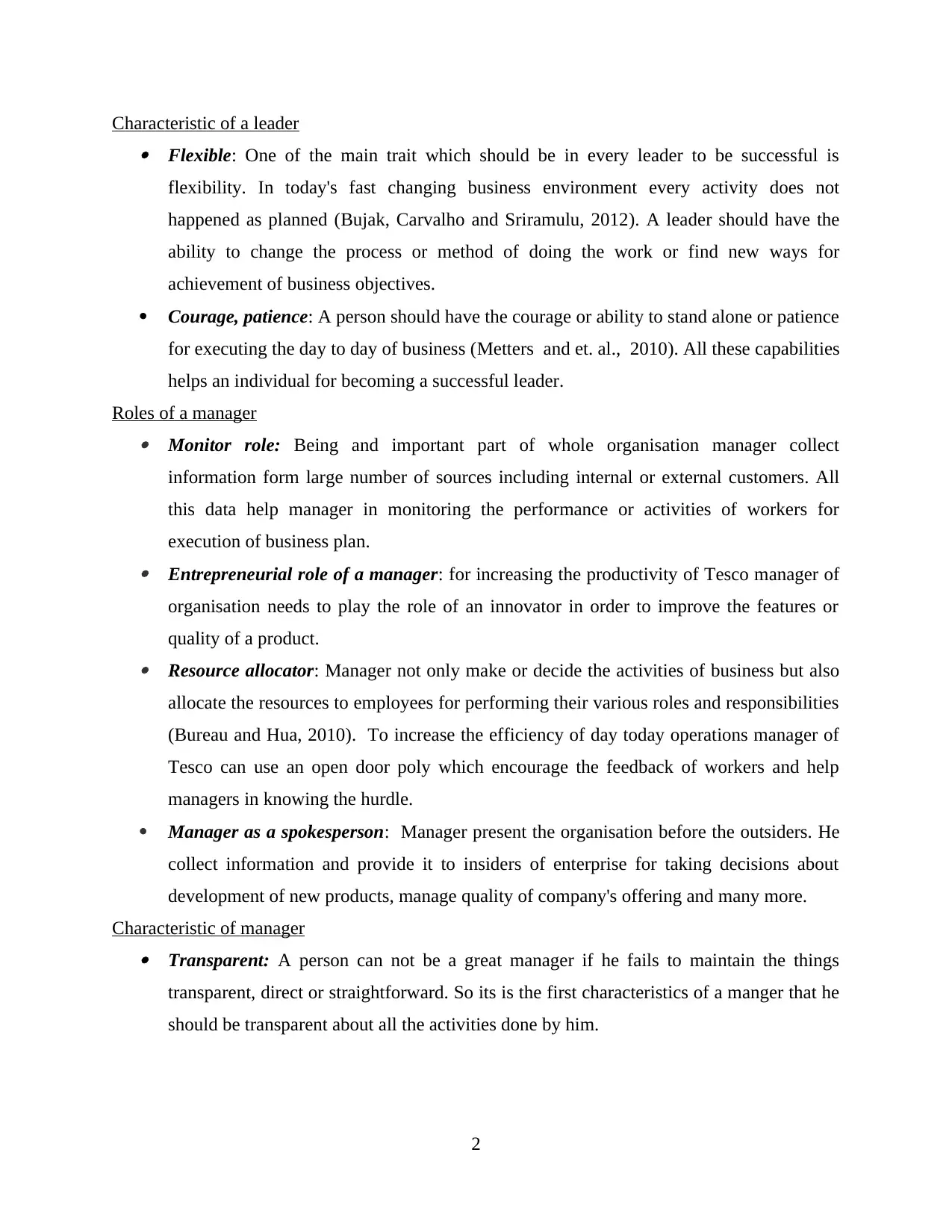
Characteristic of a leader Flexible: One of the main trait which should be in every leader to be successful is
flexibility. In today's fast changing business environment every activity does not
happened as planned (Bujak, Carvalho and Sriramulu, 2012). A leader should have the
ability to change the process or method of doing the work or find new ways for
achievement of business objectives.
Courage, patience: A person should have the courage or ability to stand alone or patience
for executing the day to day of business (Metters and et. al., 2010). All these capabilities
helps an individual for becoming a successful leader.
Roles of a manager Monitor role: Being and important part of whole organisation manager collect
information form large number of sources including internal or external customers. All
this data help manager in monitoring the performance or activities of workers for
execution of business plan. Entrepreneurial role of a manager: for increasing the productivity of Tesco manager of
organisation needs to play the role of an innovator in order to improve the features or
quality of a product. Resource allocator: Manager not only make or decide the activities of business but also
allocate the resources to employees for performing their various roles and responsibilities
(Bureau and Hua, 2010). To increase the efficiency of day today operations manager of
Tesco can use an open door poly which encourage the feedback of workers and help
managers in knowing the hurdle.
Manager as a spokesperson: Manager present the organisation before the outsiders. He
collect information and provide it to insiders of enterprise for taking decisions about
development of new products, manage quality of company's offering and many more.
Characteristic of manager Transparent: A person can not be a great manager if he fails to maintain the things
transparent, direct or straightforward. So its is the first characteristics of a manger that he
should be transparent about all the activities done by him.
2
flexibility. In today's fast changing business environment every activity does not
happened as planned (Bujak, Carvalho and Sriramulu, 2012). A leader should have the
ability to change the process or method of doing the work or find new ways for
achievement of business objectives.
Courage, patience: A person should have the courage or ability to stand alone or patience
for executing the day to day of business (Metters and et. al., 2010). All these capabilities
helps an individual for becoming a successful leader.
Roles of a manager Monitor role: Being and important part of whole organisation manager collect
information form large number of sources including internal or external customers. All
this data help manager in monitoring the performance or activities of workers for
execution of business plan. Entrepreneurial role of a manager: for increasing the productivity of Tesco manager of
organisation needs to play the role of an innovator in order to improve the features or
quality of a product. Resource allocator: Manager not only make or decide the activities of business but also
allocate the resources to employees for performing their various roles and responsibilities
(Bureau and Hua, 2010). To increase the efficiency of day today operations manager of
Tesco can use an open door poly which encourage the feedback of workers and help
managers in knowing the hurdle.
Manager as a spokesperson: Manager present the organisation before the outsiders. He
collect information and provide it to insiders of enterprise for taking decisions about
development of new products, manage quality of company's offering and many more.
Characteristic of manager Transparent: A person can not be a great manager if he fails to maintain the things
transparent, direct or straightforward. So its is the first characteristics of a manger that he
should be transparent about all the activities done by him.
2
Paraphrase This Document
Need a fresh take? Get an instant paraphrase of this document with our AI Paraphraser
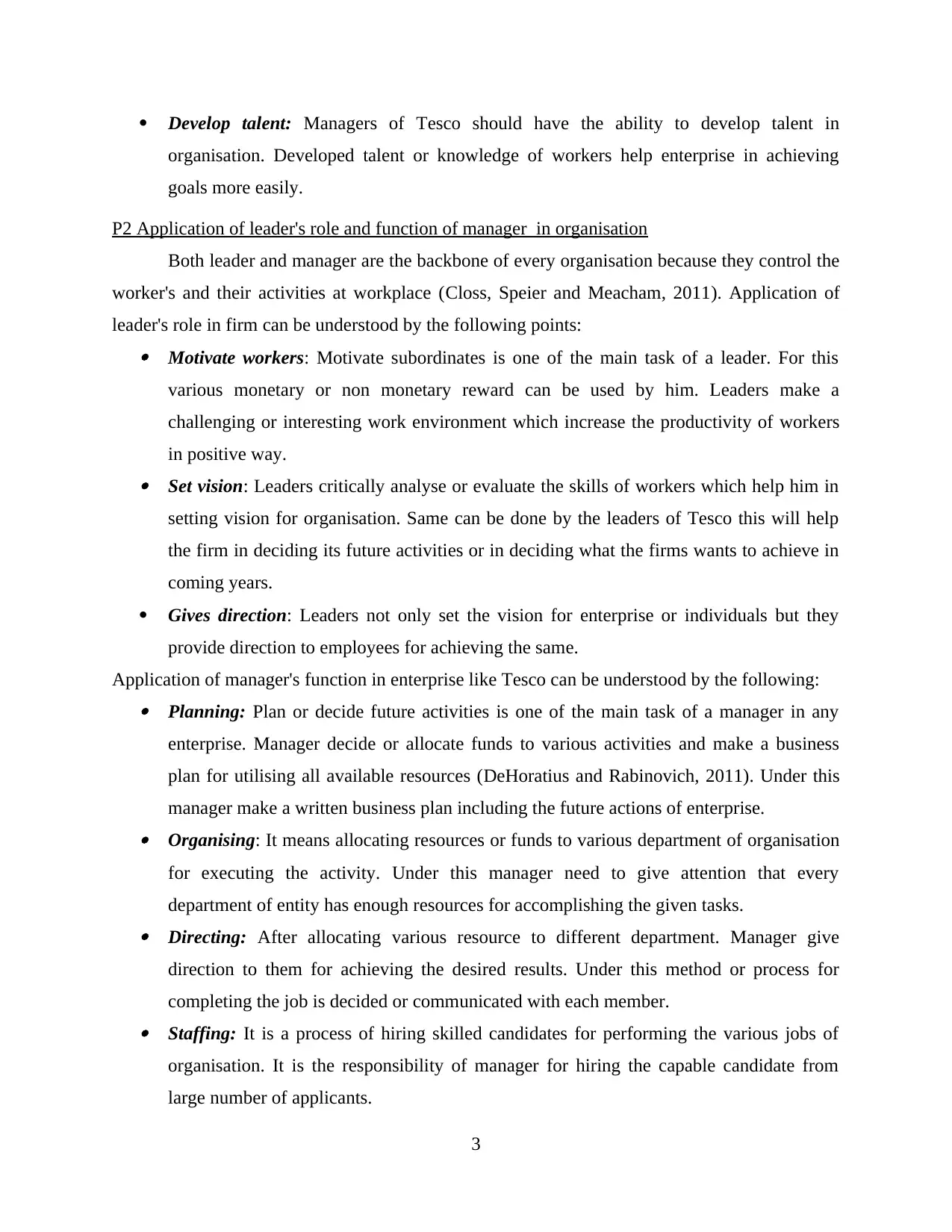
Develop talent: Managers of Tesco should have the ability to develop talent in
organisation. Developed talent or knowledge of workers help enterprise in achieving
goals more easily.
P2 Application of leader's role and function of manager in organisation
Both leader and manager are the backbone of every organisation because they control the
worker's and their activities at workplace (Closs, Speier and Meacham, 2011). Application of
leader's role in firm can be understood by the following points: Motivate workers: Motivate subordinates is one of the main task of a leader. For this
various monetary or non monetary reward can be used by him. Leaders make a
challenging or interesting work environment which increase the productivity of workers
in positive way. Set vision: Leaders critically analyse or evaluate the skills of workers which help him in
setting vision for organisation. Same can be done by the leaders of Tesco this will help
the firm in deciding its future activities or in deciding what the firms wants to achieve in
coming years.
Gives direction: Leaders not only set the vision for enterprise or individuals but they
provide direction to employees for achieving the same.
Application of manager's function in enterprise like Tesco can be understood by the following: Planning: Plan or decide future activities is one of the main task of a manager in any
enterprise. Manager decide or allocate funds to various activities and make a business
plan for utilising all available resources (DeHoratius and Rabinovich, 2011). Under this
manager make a written business plan including the future actions of enterprise. Organising: It means allocating resources or funds to various department of organisation
for executing the activity. Under this manager need to give attention that every
department of entity has enough resources for accomplishing the given tasks. Directing: After allocating various resource to different department. Manager give
direction to them for achieving the desired results. Under this method or process for
completing the job is decided or communicated with each member. Staffing: It is a process of hiring skilled candidates for performing the various jobs of
organisation. It is the responsibility of manager for hiring the capable candidate from
large number of applicants.
3
organisation. Developed talent or knowledge of workers help enterprise in achieving
goals more easily.
P2 Application of leader's role and function of manager in organisation
Both leader and manager are the backbone of every organisation because they control the
worker's and their activities at workplace (Closs, Speier and Meacham, 2011). Application of
leader's role in firm can be understood by the following points: Motivate workers: Motivate subordinates is one of the main task of a leader. For this
various monetary or non monetary reward can be used by him. Leaders make a
challenging or interesting work environment which increase the productivity of workers
in positive way. Set vision: Leaders critically analyse or evaluate the skills of workers which help him in
setting vision for organisation. Same can be done by the leaders of Tesco this will help
the firm in deciding its future activities or in deciding what the firms wants to achieve in
coming years.
Gives direction: Leaders not only set the vision for enterprise or individuals but they
provide direction to employees for achieving the same.
Application of manager's function in enterprise like Tesco can be understood by the following: Planning: Plan or decide future activities is one of the main task of a manager in any
enterprise. Manager decide or allocate funds to various activities and make a business
plan for utilising all available resources (DeHoratius and Rabinovich, 2011). Under this
manager make a written business plan including the future actions of enterprise. Organising: It means allocating resources or funds to various department of organisation
for executing the activity. Under this manager need to give attention that every
department of entity has enough resources for accomplishing the given tasks. Directing: After allocating various resource to different department. Manager give
direction to them for achieving the desired results. Under this method or process for
completing the job is decided or communicated with each member. Staffing: It is a process of hiring skilled candidates for performing the various jobs of
organisation. It is the responsibility of manager for hiring the capable candidate from
large number of applicants.
3
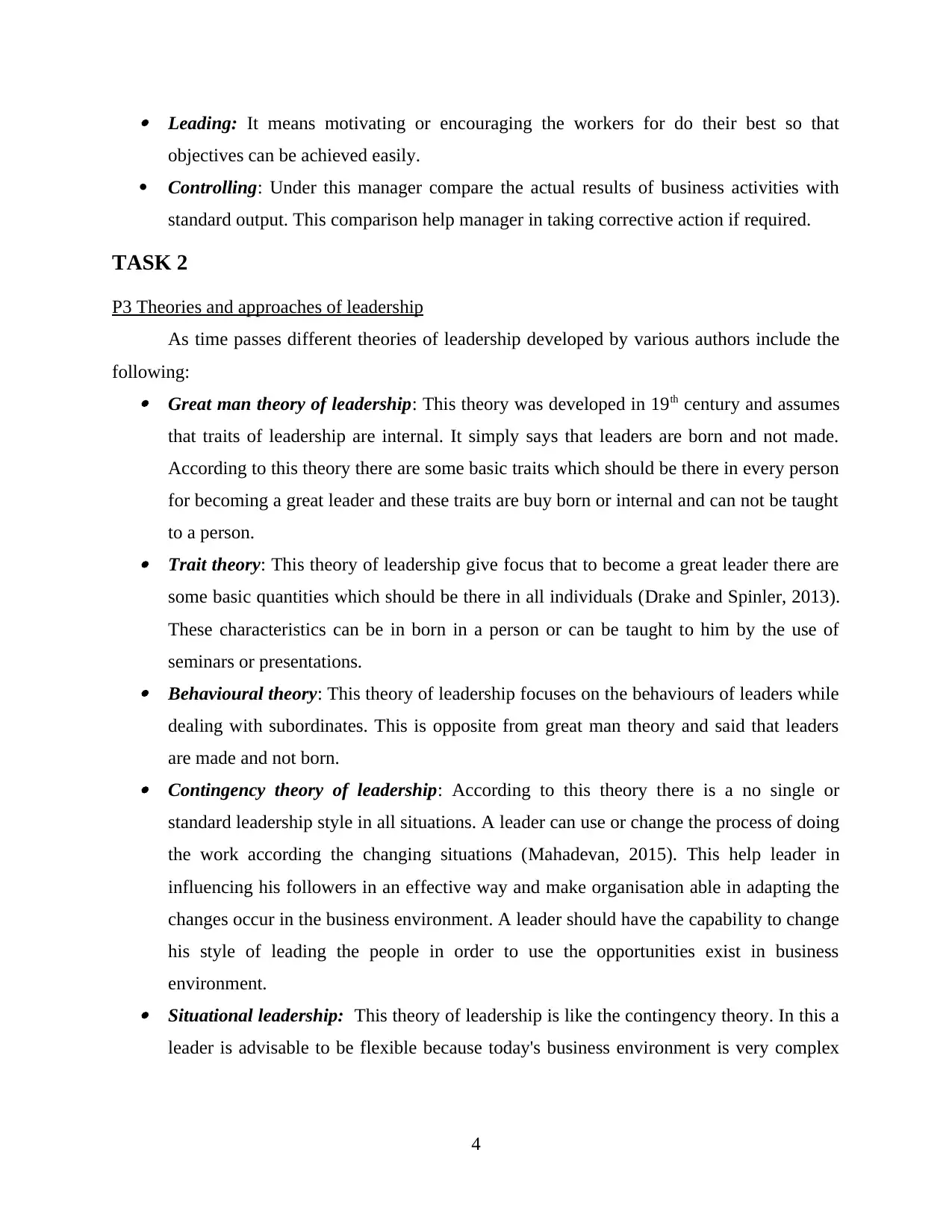
Leading: It means motivating or encouraging the workers for do their best so that
objectives can be achieved easily.
Controlling: Under this manager compare the actual results of business activities with
standard output. This comparison help manager in taking corrective action if required.
TASK 2
P3 Theories and approaches of leadership
As time passes different theories of leadership developed by various authors include the
following: Great man theory of leadership: This theory was developed in 19th century and assumes
that traits of leadership are internal. It simply says that leaders are born and not made.
According to this theory there are some basic traits which should be there in every person
for becoming a great leader and these traits are buy born or internal and can not be taught
to a person. Trait theory: This theory of leadership give focus that to become a great leader there are
some basic quantities which should be there in all individuals (Drake and Spinler, 2013).
These characteristics can be in born in a person or can be taught to him by the use of
seminars or presentations. Behavioural theory: This theory of leadership focuses on the behaviours of leaders while
dealing with subordinates. This is opposite from great man theory and said that leaders
are made and not born. Contingency theory of leadership: According to this theory there is a no single or
standard leadership style in all situations. A leader can use or change the process of doing
the work according the changing situations (Mahadevan, 2015). This help leader in
influencing his followers in an effective way and make organisation able in adapting the
changes occur in the business environment. A leader should have the capability to change
his style of leading the people in order to use the opportunities exist in business
environment. Situational leadership: This theory of leadership is like the contingency theory. In this a
leader is advisable to be flexible because today's business environment is very complex
4
objectives can be achieved easily.
Controlling: Under this manager compare the actual results of business activities with
standard output. This comparison help manager in taking corrective action if required.
TASK 2
P3 Theories and approaches of leadership
As time passes different theories of leadership developed by various authors include the
following: Great man theory of leadership: This theory was developed in 19th century and assumes
that traits of leadership are internal. It simply says that leaders are born and not made.
According to this theory there are some basic traits which should be there in every person
for becoming a great leader and these traits are buy born or internal and can not be taught
to a person. Trait theory: This theory of leadership give focus that to become a great leader there are
some basic quantities which should be there in all individuals (Drake and Spinler, 2013).
These characteristics can be in born in a person or can be taught to him by the use of
seminars or presentations. Behavioural theory: This theory of leadership focuses on the behaviours of leaders while
dealing with subordinates. This is opposite from great man theory and said that leaders
are made and not born. Contingency theory of leadership: According to this theory there is a no single or
standard leadership style in all situations. A leader can use or change the process of doing
the work according the changing situations (Mahadevan, 2015). This help leader in
influencing his followers in an effective way and make organisation able in adapting the
changes occur in the business environment. A leader should have the capability to change
his style of leading the people in order to use the opportunities exist in business
environment. Situational leadership: This theory of leadership is like the contingency theory. In this a
leader is advisable to be flexible because today's business environment is very complex
4
⊘ This is a preview!⊘
Do you want full access?
Subscribe today to unlock all pages.

Trusted by 1+ million students worldwide
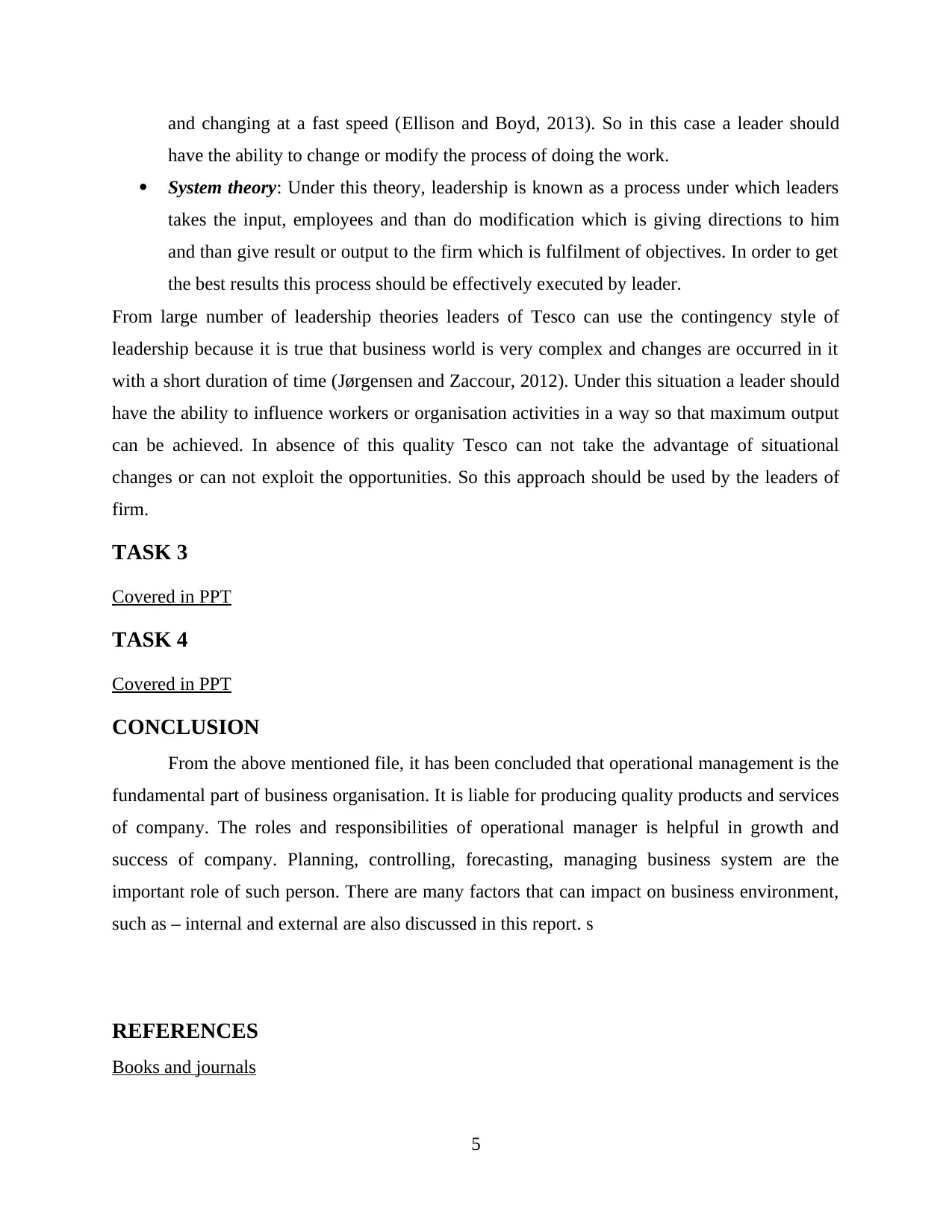
and changing at a fast speed (Ellison and Boyd, 2013). So in this case a leader should
have the ability to change or modify the process of doing the work.
System theory: Under this theory, leadership is known as a process under which leaders
takes the input, employees and than do modification which is giving directions to him
and than give result or output to the firm which is fulfilment of objectives. In order to get
the best results this process should be effectively executed by leader.
From large number of leadership theories leaders of Tesco can use the contingency style of
leadership because it is true that business world is very complex and changes are occurred in it
with a short duration of time (Jørgensen and Zaccour, 2012). Under this situation a leader should
have the ability to influence workers or organisation activities in a way so that maximum output
can be achieved. In absence of this quality Tesco can not take the advantage of situational
changes or can not exploit the opportunities. So this approach should be used by the leaders of
firm.
TASK 3
Covered in PPT
TASK 4
Covered in PPT
CONCLUSION
From the above mentioned file, it has been concluded that operational management is the
fundamental part of business organisation. It is liable for producing quality products and services
of company. The roles and responsibilities of operational manager is helpful in growth and
success of company. Planning, controlling, forecasting, managing business system are the
important role of such person. There are many factors that can impact on business environment,
such as – internal and external are also discussed in this report. s
REFERENCES
Books and journals
5
have the ability to change or modify the process of doing the work.
System theory: Under this theory, leadership is known as a process under which leaders
takes the input, employees and than do modification which is giving directions to him
and than give result or output to the firm which is fulfilment of objectives. In order to get
the best results this process should be effectively executed by leader.
From large number of leadership theories leaders of Tesco can use the contingency style of
leadership because it is true that business world is very complex and changes are occurred in it
with a short duration of time (Jørgensen and Zaccour, 2012). Under this situation a leader should
have the ability to influence workers or organisation activities in a way so that maximum output
can be achieved. In absence of this quality Tesco can not take the advantage of situational
changes or can not exploit the opportunities. So this approach should be used by the leaders of
firm.
TASK 3
Covered in PPT
TASK 4
Covered in PPT
CONCLUSION
From the above mentioned file, it has been concluded that operational management is the
fundamental part of business organisation. It is liable for producing quality products and services
of company. The roles and responsibilities of operational manager is helpful in growth and
success of company. Planning, controlling, forecasting, managing business system are the
important role of such person. There are many factors that can impact on business environment,
such as – internal and external are also discussed in this report. s
REFERENCES
Books and journals
5
Paraphrase This Document
Need a fresh take? Get an instant paraphrase of this document with our AI Paraphraser

Ashby, A., Leat, M. and Hudson-Smith, M., 2012. Making connections: a review of supply chain
management and sustainability literature.Supply Chain Management: An International
Journal. 17(5) pp.497-516.
Binder, M. and Edwards, J.S., 2010. Using grounded theory method for theory building in
operations management research: A study on inter-firm relationship governance.
International Journal of Operations & Production Management. 30(3). pp.232-259.
Brandenburg, M and et.al., 2014. Quantitative models for sustainable supply chain management:
Developments and directions.European Journal of Operational Research. 233(2)
pp.299-312.
Bujak, A., Carvalho, W. and Sriramulu, R., 2012. Lean management and operations in the global
professional services industry. In Globalization of professional services (pp. 95-104).
Springer Berlin Heidelberg.
Bureau, D.P. and Hua, K., 2010. Towards effective nutritional management of waste outputs in
aquaculture, with particular reference to salmonid aquaculture operations.Aquaculture
Research. 41(5) pp.777-792.
Closs, D.J., Speier, C. and Meacham, N., 2011. Sustainability to support end-to-end value chains:
the role of supply chain management. Journal of the Academy of Marketing Science.
39(1) pp.101-116.
David, F.R., 2011. Strategic management: Concepts and cases. Peaeson/Prentice Hall.
DeHoratius, N. and Rabinovich, E., 2011. Field research in operations and supply chain
management.
Drake, D.F. and Spinler, S., 2013. OM Forum—Sustainable Operations Management: An
Enduring Stream or a Passing Fancy?. Manufacturing & Service Operations
Management. 15(4) pp.689-700.
Ellison, N.B. and Boyd, D.M., 2013. Sociality through social network sites. InThe Oxford
handbook of internet studies.
Jørgensen, S. and Zaccour, G., 2012. Differential games in marketing(Vol. 15). Springer Science
& Business Media.
Mahadevan, B., 2015.Operations management: Theory and practice. Pearson Education India.
Metters, R and et.al., 2010. “The way that can be told of is not an unvarying way”: Cultural
impacts on Operations Management in Asia.
Montes, F and et.al., 2013. SPECIAL TOPICS—mitigation of methane and nitrous oxide
emissions from animal operations: II. A review of manure management mitigation
options.Journal of Animal Science. 91(11) pp.5070-5094.
Nagurney, A., Masoumi, A.H. and Yu, M., 2012. Supply chain network operations management
of a blood banking system with cost and risk minimization. Computational Management
Science. 9(2) pp.205-231.
Rani, D. and Moreira, M.M., 2010. Simulation–optimization modeling: a survey and potential
application in reservoir systems operation.Water resources management. 24(6) pp.1107-
1138.
Online
Difference Between Leadership and Management. 2015. [Online]. Available through:
<http://keydifferences.com/difference-between-leadership-and-management.html>.
[Accessed on 19 June 2017].
6
management and sustainability literature.Supply Chain Management: An International
Journal. 17(5) pp.497-516.
Binder, M. and Edwards, J.S., 2010. Using grounded theory method for theory building in
operations management research: A study on inter-firm relationship governance.
International Journal of Operations & Production Management. 30(3). pp.232-259.
Brandenburg, M and et.al., 2014. Quantitative models for sustainable supply chain management:
Developments and directions.European Journal of Operational Research. 233(2)
pp.299-312.
Bujak, A., Carvalho, W. and Sriramulu, R., 2012. Lean management and operations in the global
professional services industry. In Globalization of professional services (pp. 95-104).
Springer Berlin Heidelberg.
Bureau, D.P. and Hua, K., 2010. Towards effective nutritional management of waste outputs in
aquaculture, with particular reference to salmonid aquaculture operations.Aquaculture
Research. 41(5) pp.777-792.
Closs, D.J., Speier, C. and Meacham, N., 2011. Sustainability to support end-to-end value chains:
the role of supply chain management. Journal of the Academy of Marketing Science.
39(1) pp.101-116.
David, F.R., 2011. Strategic management: Concepts and cases. Peaeson/Prentice Hall.
DeHoratius, N. and Rabinovich, E., 2011. Field research in operations and supply chain
management.
Drake, D.F. and Spinler, S., 2013. OM Forum—Sustainable Operations Management: An
Enduring Stream or a Passing Fancy?. Manufacturing & Service Operations
Management. 15(4) pp.689-700.
Ellison, N.B. and Boyd, D.M., 2013. Sociality through social network sites. InThe Oxford
handbook of internet studies.
Jørgensen, S. and Zaccour, G., 2012. Differential games in marketing(Vol. 15). Springer Science
& Business Media.
Mahadevan, B., 2015.Operations management: Theory and practice. Pearson Education India.
Metters, R and et.al., 2010. “The way that can be told of is not an unvarying way”: Cultural
impacts on Operations Management in Asia.
Montes, F and et.al., 2013. SPECIAL TOPICS—mitigation of methane and nitrous oxide
emissions from animal operations: II. A review of manure management mitigation
options.Journal of Animal Science. 91(11) pp.5070-5094.
Nagurney, A., Masoumi, A.H. and Yu, M., 2012. Supply chain network operations management
of a blood banking system with cost and risk minimization. Computational Management
Science. 9(2) pp.205-231.
Rani, D. and Moreira, M.M., 2010. Simulation–optimization modeling: a survey and potential
application in reservoir systems operation.Water resources management. 24(6) pp.1107-
1138.
Online
Difference Between Leadership and Management. 2015. [Online]. Available through:
<http://keydifferences.com/difference-between-leadership-and-management.html>.
[Accessed on 19 June 2017].
6

7
⊘ This is a preview!⊘
Do you want full access?
Subscribe today to unlock all pages.

Trusted by 1+ million students worldwide

8
1 out of 10
Related Documents
Your All-in-One AI-Powered Toolkit for Academic Success.
+13062052269
info@desklib.com
Available 24*7 on WhatsApp / Email
![[object Object]](/_next/static/media/star-bottom.7253800d.svg)
Unlock your academic potential
Copyright © 2020–2025 A2Z Services. All Rights Reserved. Developed and managed by ZUCOL.





